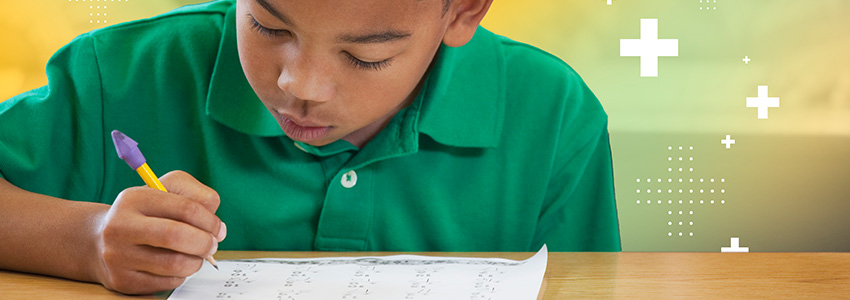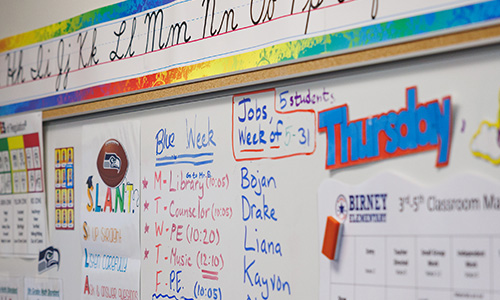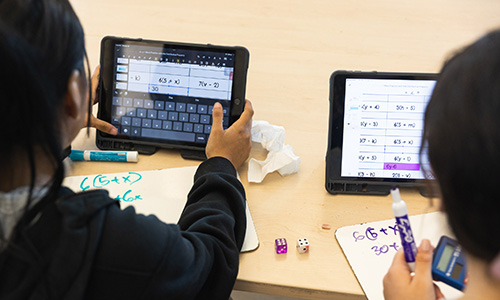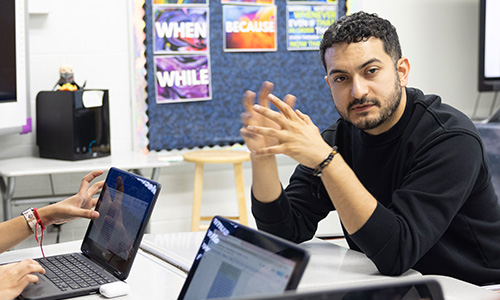
More and more, math teachers are being called upon to “make the learning relevant” and provide real-world context and problem-based learning. This raises some questions: Pragmatically, is math irrelevant? More esoterically, what is “real”? And, most famously, “When will we need to know this?”
Most math teachers have been here before. We’ve all transposed the names of our own students for those in a word problem. We’ve all used our school community goings-on as fodder for plot lines: “If 89 middle schoolers are traveling on buses to Outdoor School, and each bus can transport 35 students and four chaperones.…” But how “real world” are we really getting?
We—Kailey Rhodes and Kristen Tsutsui, math teachers and authors of this blog post—wanted to know teachers’ experience with real-world problem-solving, what’s going well, and what’s in their way. So we surveyed some. In this post, we’ll walk you through what we asked, learned, and think as we move forward—and we’ll also share the resources our teachers shared with us. But first, let us introduce you to an official definition of real-world context in the math classroom.
The PISA Mathematics Framework
PISA is an international assessment administered to 15-year-olds globally. In their 2022 Mathematics Framework, PISA explains the underpinnings of their assessment as it relates to math literacy, reasoning, and problem-solving. It also stipulates that to uplift these underpinnings, mathematics problems should be presented in real-world contexts: personal, occupational, societal, and scientific.
Educators, take a moment to read the descriptions of these contexts. As you read, ask yourself the question we asked in our survey: “Which do you naturally find yourself gravitating toward in your classroom?”
- Personal: “Problems classified in the personal context category focus on activities of one’s self, one’s family, or one’s peer group. Personal contexts include (but are not limited to) those involving food preparation, shopping, games, personal health, personal transportation, sports, travel, personal scheduling, and personal finance.”
- Occupational: “Problems classified in the occupational context category are centered on the world of work. Items categorized as occupational may involve (but are not limited to) such things as measuring, costing, and ordering materials for building, payroll/accounting, quality control, scheduling/inventory, design/architecture, and job-related decision-making. Occupational contexts may relate to any level of the workforce, from unskilled work to the highest levels of professional work, although items in the PISA survey must be accessible to 15-year-old students.”
- Societal: “Problems classified in the societal context category focus on one’s community (whether local, national, or global). They may involve (but are not limited to) such things as voting systems, public transport, government, public policies, demographics, advertising, national statistics, and economics. Although individuals are involved in all of these things in a personal way, in the societal context category, the focus of problems is on the community perspective.”
- Scientific: “Problems classified in the scientific category relate to the application of mathematics to the natural world and issues and topics related to science and technology. Particular contexts might include (but are not limited to) such areas as weather or climate, ecology, medicine, space science, genetics, measurement, and the world of mathematics itself. Items that are intra-mathematical, where all the elements involved belong in the world of mathematics, fall within the scientific context.”
Which context did you most resonate with? If you were to focus on one context per quarter, how would you order them? What is your biggest struggle with real-world context and problem-based learning? How do you bring the “real world” inside your classroom?
We surveyed a focus group of math teachers, from kindergarten to IB, to see what they thought.
Survey says!
When we asked our teachers, “Which do you naturally find yourself gravitating toward in your classroom?” personal and scientific contexts were the winners, with societal coming in fourth. Our guess for this is that societal is not only ever-changing but is also often politically adjacent, something educators can, understandably, be wary of approaching.
Naturally, personal real-world math context offers an entry point into students’ interests, which is paramount in the math classroom. One teacher said, “Good projects that connect to the curriculum and also interest the students are worth their weight in gold. I really wish publishers did a better job of planning good projects; in most books I’ve used, the projects, if they exist at all, are an afterthought and poorly done.”
When it comes to other contexts, like societal, the bullseye of curriculum connection, student interest level, and math teacher time is a hard one to hit. As one teacher said, “With more time I would like to start new math topics with ‘real world problems’ and have the students brainstorm what knowledge would be useful to solve them, building resilience in the face of complex problems. However, these kinds of freeform explorations take time that I often feel like I don’t have in my class.”
This theme of “not enough time” appeared often, with teachers expressing a desire for more real-world presence, including cross-collaboration with other colleagues. A teacher said, “I have tried to coordinate with science classes to talk about the mathematical aspects of science concepts they are learning, but it can be hard to coordinate and map those kinds of things onto my own curriculum.”
This was echoed in the teachers’ comments, along with many wishful statements about what they “would do…if.”
With all the time and resources, what would teachers do?
We asked teachers to describe their dream scenario: what they would do if they had more resources, time, and permission. In most responses, what stood out was teachers’ love for math’s interconnectedness and innate curiosity. Some dreamed big:
- “An interdisciplinary project across all subjects that would allow students to see how math applies to all facets of the world”
- “Something like ‘a history of mathematical thought,’ bringing history, culture, psychology, ecology, science, and engineering into the curriculum”
- “Students being given the opportunity to explore a problem they are passionate about and explore ways that mathematics can be used to help solve it”
- “Students working alongside professionals in various math-related fields so they can see, firsthand, how the math they are learning is currently being used”
It’s clear that teachers want to provide classroom experiences that both underscore math’s omnipresence in the world around us and ignite students’ interests. It’s also clear that when your survey takers have to type qualifiers like, “But this would take a lot of time” and “We don’t have the resources for this,” the “real world” is actually what’s in the way. So, what can be done?
From ideal to real: Helpful tips & a relaxing thought on problem-based learning
No one knows better than math teachers that you can’t add time to your school day. But, through our interactions with teachers, we walked away with some resources and tips to share with you. Here are the gems:
- Split it into quadrants. Most teachers surveyed would order their quarters and contexts like this: first quarter, personal; second quarter, societal; third quarter, scientific; fourth quarter, occupational.
- Switch with science. One teacher said this: “Actually switch classes with a science teacher to reiterate how what they are learning in science is related to what we do in math. And then they can come to my class to do the same so they can really understand the connection.”
- Draw a parallel. “Have a project that seems like it might belong in an arts classroom, like creating a piece of clothing,” another teacher suggested. “They have to use multiple modes of mathematical knowledge to do this, like unit conversions (centimeters to inches to yards), spatial constraints (if fabric is a certain size, can I fit my pattern in it? How big do the pieces have to be to fit on the body?), and area (how much fabric do I need?).”
- Estimate. “I use Estimation 180, but I gamify it to address average, mean, median, and mode. I have students secretly record their estimations, and I write them all on the board. We discuss the average classroom guess and how close our range is. Estimation is everywhere.”
- Level up. “I’ve been using Skew the Script to heighten engagement for all my students and teach them about larger global issues affecting society. Their After The AP Data Science Challenge aims to solve the real (unsolved) problem of finding a model to predict the best and worst colleges for conquering student debt.”
- Build the roster: “Try to arrange a handful of yearly speakers and field trips you can count on to bring the math to life. My husband is a civil engineer and uses the Pythagorean theorem. You’d be surprised how many folks would love to come in and talk to a math class—with your teacher guidance and enthusiasm, of course.”
And now for the relaxing thought: Start small. As with any endeavor in the classroom, no matter the discipline, the key is to work incrementally. We already know how important increments are, right, math teachers?
What is “real,” anyway?
Let’s return to the age-old question of, “When will we ever use this?” It plagues math teachers perhaps more than any other discipline, and the task of “real-world” problem-solving often feels like a “gotcha” moment. The fact is, sometimes, we math teachers don’t have a great real-world example of dividing negative fractions in our back pocket. But does that mean that it isn’t worth learning? Must every concept in math be nested perfectly within the “real” world?
In one particular mic-drop moment, one of our teachers shared, “I think the label ‘real-world’ has been used extensively in math education, and I’ve found it a bit frustrating. In many regards, math is the least ‘real’ discipline we teach children. It is, largely, the art of abstraction! That it is ‘real’ is in many ways the least interesting and important thing about it as a system of thinking, and this is often lost when continually looked at with the question ‘When will we ever use this?’”
Maybe when we’ll “use this” is when we’re thinking through a problem with many facets and variables. Math is, after all, less of a “what” and more of a “how.” How should we go about solving this? How do we use computational thinking to solve problems? How do we spiral what we already know with what we don’t?
We’re teaching kids how to think—and isn’t that the most real-world skill we can possibly teach?
To learn more about how NWEA can support you in teaching math, visit our website.







